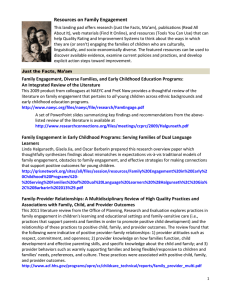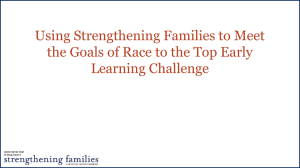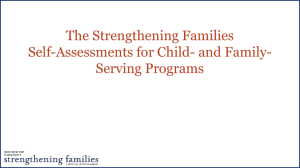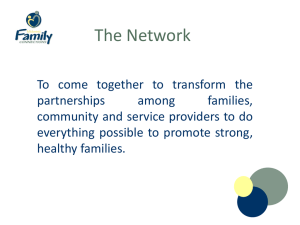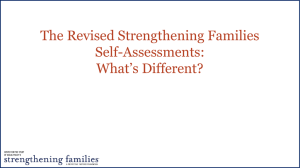Resource List, Session 2 - 2014 Diversity Equity Learning Table
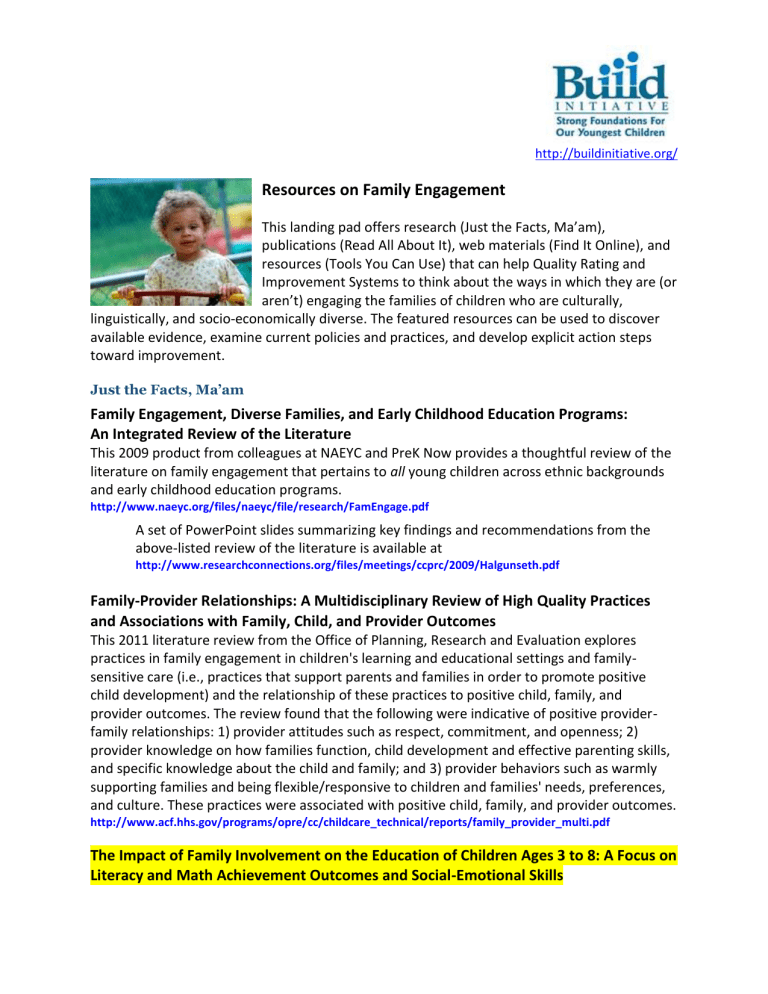
http://buildinitiative.org/
Resources on Family Engagement
This landing pad offers research (Just the Facts, Ma’am), publications (Read All About It), web materials (Find It Online), and resources (Tools You Can Use) that can help Quality Rating and
Improvement Systems to think about the ways in which they are (or aren’t) engaging the families of children who are culturally, linguistically, and socio-economically diverse. The featured resources can be used to discover available evidence, examine current policies and practices, and develop explicit action steps toward improvement.
Just the Facts, Ma’am
Family Engagement, Diverse Families, and Early Childhood Education Programs:
An Integrated Review of the Literature
This 2009 product from colleagues at NAEYC and PreK Now provides a thoughtful review of the literature on family engagement that pertains to all young children across ethnic backgrounds and early childhood education programs. http://www.naeyc.org/files/naeyc/file/research/FamEngage.pdf
A set of PowerPoint slides summarizing key findings and recommendations from the above-listed review of the literature is available at http://www.researchconnections.org/files/meetings/ccprc/2009/Halgunseth.pdf
Family-Provider Relationships: A Multidisciplinary Review of High Quality Practices and Associations with Family, Child, and Provider Outcomes
This 2011 literature review from the Office of Planning, Research and Evaluation explores practices in family engagement in children's learning and educational settings and familysensitive care (i.e., practices that support parents and families in order to promote positive child development) and the relationship of these practices to positive child, family, and provider outcomes. The review found that the following were indicative of positive providerfamily relationships: 1) provider attitudes such as respect, commitment, and openness; 2) provider knowledge on how families function, child development and effective parenting skills, and specific knowledge about the child and family; and 3) provider behaviors such as warmly supporting families and being flexible/responsive to children and families' needs, preferences, and culture. These practices were associated with positive child, family, and provider outcomes. http://www.acf.hhs.gov/programs/opre/cc/childcare_technical/reports/family_provider_multi.pdf
The Impact of Family Involvement on the Education of Children Ages 3 to 8: A Focus on
Literacy and Math Achievement Outcomes and Social-Emotional Skills
This report summarizes resource conducted primarily over the past 10 years on how families’ involvement in children’s learning and development through activities at home or at school affects the literacy, mathematics, and social-emotional skills of children ages 3 to 8. http://www.mdrc.org/publication/impact-family-involvement-education-children-ages-3-8
Read All About It
Partnering With Parents in Formal Child Care Settings
Anne Douglass’ study, as described in this article in Early Childhood Research & Practice, examined the influence of the organizational context on the quality of family partnerships in four ECE programs involved in the Strengthening Families initiative in one state and tested the theory of a “relational bureaucratic” organizational system as a determinant of high-quality family partnerships in formal child care settings. Results showed that (1) a “relational bureaucratic” organizational context was associated with high-quality family partnership practices and (2) a “conventional bureaucratic” context was associated with low-quality family partnership practices. The “relational bureaucratic” organizations shared several key characteristics, including administrators who model and support caring and responsive staff relationships within the organization and the use of specific structures and processes to promote a caring and responsive professionalism. Results point to the importance of a relationship-centered organizational system as a key ingredient for effective partnerships with families, with implications for policy and practice. http://ecrp.uiuc.edu/v13n2/douglass.html
See For Yourself
Language and Culture: Respecting Family Choices
This video shares the perspectives of families faced with questions that impact their children’s learning of two languages and preservation of their culture and heritage. Family and provider views can be used to shape thinking about ways to authentically engage family members in the programs that support their children. Boulder, CO: Landlocked Films. Cost: $49.95 http://shop.landlockedfilms.info/
A Story About El Grupo De Famílías
Come join the early childhood literacy group, “El Grupo de Familias” through ten sessions of discovering interactive reading and play and forming friendships. Families receive vital information about preserving home language and culture, navigating the school system, advocating for kids with special needs, and accessing resources in the community. Designed for parents and educators alike, this bilingual English/Spanish DVD contains a series of short modules that focus on specific steps in the process of building trust, teaching literacy skills, and empowering parents to support their kids’ learning. Boulder, CO: Landlocked Films. Cost:
$65.95 http://shop.landlockedfilms.info/
QRIS and Family Engagement – A Strengthening Families
Approach
2
This webinar highlighted findings and key examples from states that have used the
Strengthening Families resources to support family engagement efforts. Examples revealed experiences at both the state and program level. http://qrisnetwork.org/sites/all/files/materials/QRIS%20and%20Family%20Engagement%20PowerPoint.pdf
(PowerPoint slides) http://qrisnetwork.org/member/calendar/event/130130/qris-and-family-engagement-strengtheningfamiliestm-approach (recording)
The Transatlantic Forum on Inclusive Early Years. Investing in the Development of
Young Children from Immigrant and Low-income Families
This international forum brought together leading scientists, practitioners, civil society members, business leaders, and political decision makers from Europe and North America to explore what systems, standards, and regulations have been successful in family engagement.
Participants examined how to engage migrant and low-income family members to become their children's "first teachers" and life-long advocates for their children's education.
The video and PowerPoint slides from the meeting present a variety of perspectives from around Europe and the U.S. about how to engage families. http://www.youtube.com/watch?v=Pv7VgChSg8s&feature=share&list=PL17gcPJzCrQWAyCa5Lt5mOCKbDFTb4Q
N7 (video) http://www.kbs-frb.be/uploadedFiles/2012-KBS-
FRB/05%29_Pictures,_documents_and_external_sites/13%29_Speech/2014_TFIEY_HWeis.pdf
(PowerPoints)
Find It Online
Building Culturally & Linguistically Competent Services to Support Young Children,
Their Families, and School Readiness
This multi-faceted resource offers suggestions, tip sheets, guides and self-assessment tools to nurture early childhood development and increase school readiness for young children who are culturally and linguistically diverse and their families. http://www.aecf.org/upload/PublicationFiles/HS3622H325.pdf
Engaged Families, Effective Pre-K: State Policies That Bolster Student Success
This report from Pre-K Now identifies policies that can enhance family engagement in state prekindergarten and highlights examples from states that are leading the way. The report, written by Deborah Roderick Stark, also addresses how family engagement programs must ensure efforts to respect the linguistic and cultural diversity of the populations they serve. http://www.pewtrusts.org/uploadedFiles/wwwpewtrustsorg/Reports/
Pre-k_education/PkN_Family_Engagement_FINAL.pdf
Exploration of the Status of Services for Immigrant Families in Early Childhood
Education Programs
Authors Colleen Vesely and Mark Ginsberg have organized this thoughtful summary of their research around four themes: ( 1) improving quality of and access to ECE programs for immigrant families, (2) building relationships with immigrant parents and families, (3) supporting immigrant parents’ identity development and representation in their communities,
3
and (4) fostering staff dynamics, development, and well-being. Each of these is explored individually in the report, in terms of dynamics as well as recommendations for ECE programs currently working with immigrant families. http://build.fpg.unc.edu/sites/build.fpg.unc.edu/files/resources/Vesely-Ginsberg-
ServicesForImmigrantFamiliesInEC-2011.pdf
Family and Community Involvement
Family and Community Involvement is geared toward teachers, principals, and superintendents who want to develop meaningful parent and community involvement from culturally and linguistically diverse community members. It provides tips on how to communicate effectively with family members and how to make them comfortable in your setting. This resource is available in English and Spanish. http://www.sedl.org/pubs/catalog/items/fam29.html
Family Engagement and Family-Sensitive Caregiving: Identifying Common Core
Elements and Issues Related to Measurement
The purpose of this brief is to summarize discussion from a two-day meeting regarding common core elements of family engagement and family-sensitive caregiving and issues related to the research and measurement of these concepts.
http://www.childcareresearch.org/childcare/resources/22296/pdf
Family Engagement in Early Childhood: A Resource Guide for Early Learning Challenge
Grant Recipients
To support RTTT–ELC grant recipients’ efforts, Harvard Family Research Project produced this selective list of resources about engaging and supporting families with young children. The list of journal articles, practical guides, webinars, and presentations will be useful for any states, districts, and local programs interested in expanding their family engagement work. http://www.hfrp.org/family-involvement/publications-resources/family-engagement-inearly-childhood-a-resource-guide-for-early-learning-challenge-grant-recipients
Guide to the “Family Involvement” Element of California's Quality Rating and
Improvement System
This resource summarizes the California Early Learning Quality Improvement System (CAEL QIS) Advisory
Committee’s Family Engagement Subcommittee’s recommendations for promoting engagement for all families. It offers helpful definitions, a review of relevant literature, and a tiered system, based on mutual respect and two-way communication that could be used as a measure of family involvement. www.cde.ca.gov/sp/cd/re/documents/whitepaper.doc
Parent Priorities in Selecting Early Learning Programs: Implications for Minnesota’s
Quality Rating & Improvement System
The February 2010 study, authored by Dr. Aisha Ray, draws on information gathered from four focus groups and interviews with parents and child care providers from six of Minnesota's cultural communities – African American, American Indian, Hmong, Karen, Latino, and Somali –
4
and was designed to explore questions surrounding how culture and language factor in the early care and education choices of parents and how that information could be reflected in
Parent Aware, Minnesota's Quality Rating and Improvement System. https://s3.amazonaws.com/Omnera/VerV/s3finder/38/pdf/Dr_Ray_Study_Parent_Priorities
_February_2010.pdf
(full report) http://www.mncpd.org/docs/MELF_Cultural_Relevance_Study_Fact_Sheet_
Feb_20_2010.pdf
(fact sheet)
Quality Rating and Improvement Systems (QRIS) and Family-Sensitive Caregiving in
Early Care and Education Arrangements: Promising Directions and Challenges
Given the limited research on family partnerships, one of the challenges for policy makers and researchers who are engaged in work on QRIS is how to develop and measure indicators that accurately capture this aspect of quality. Several conceptual models provide insights into possible directions for assessment. This brief aims to inform discussions about relevant and meaningful indicators by examining QRIS family partnership standards through the lens of one of these conceptual models, specifically, the model of family-sensitive caregiving.
http://www.acf.hhs.gov/programs/opre/cc/childcare_technical/reports/qrisfsc.pdf
Reaching All Children: Understanding Early Care and Education Participation Among
Immigrant Families
This paper summarizes evidence about the participation of young children of immigrants in early care and education programs as well as relevant demographic and socioeconomic characteristics of immigrant families that likely influence children’s participation in early learning programs. It then discusses policy recommendations for state and local administrators of prekindergarten and other early care and education programs, and proposes areas for additional research. http://www.clasp.org/admin/site/publications/files/0267.pdf
Strengthening Families
Strengthening Families is a framework developed by the Center for the Study of Social Policy
(CSSP) over the last decade to prevent child abuse and neglect. This approach helps child welfare systems, early education and other programs work with families to build the following protective factors: resilience, social connections, concrete support in times of need, knowledge of parenting and child development, and social and emotional competence of children. The
Strengthening Families website has an array of tools and resources that can be used to support family engagement, including State Approaches to Integrating Strengthening Families into
Quality Rating and Improvement Systems (http://www.dhhs.nh.gov/dcyf/cdb/documents/sf-article.pdf). http://www.cssp.org/reform/strengthening-families
Tools You Can Use
Bringing the Protective Factors Framework to Life in Your Work: A Resource for Action
5
The National Alliance of Children’s Trust and Prevention Funds (Alliance) has produced a series of online training courses to support implementation of the Strengthening Families™ Protective
Factors Framework in multiple settings. The curriculum contains seven courses – one on each of the five protective factors, an introduction that can stand alone as a brief orientation to this work and a wrap-up course to help participants translate knowledge into action. Each course is approximately two hours in length. With a mix of written text, video and audio clips and opportunities to interact with the material, the courses are designed to keep the learner engaged. An online forum on the course site allows learners to interact with each other.
Learners can develop a portfolio of completed assignments to demonstrate their progress and can create individual action plans. http://www.ctfalliance.org/onlinetraining.htm
(click on the link in the left column that says
“Go to the online training course.” You will need to create a user name and password.
The Head Start Parent, Family, and Community Engagement Framework: Promoting
Family Engagement and School Readiness, From Prenatal to Age 8
The first section of this framework outlines the importance of a systemic, integrated and comprehensive approach to family engagement. Seven outcomes are identified, with a definition given of each, along with strategies and examples of family progress for each outcome area. http://www.nhsa.org/files/static_page_files/2E210DAB-1D09-3519-
AD0726E950C35FEE/pfce-framework.pdf
National Center on Parent, Family, and Community Engagement
This website features the Head Start Parent, Family, and Community Engagement Framework and tools, a collection of resources that were designed to support was created to promote effective parent, family, and community engagement in support of young children's learning, development, and school readiness. The Framework emphasizes four key themes: 1) Program environment – families feel welcomed, valued and respected by program staff; 2) Family partnerships – staff and families work together to identify and achieve parent/goals and aspirations; 3) Teaching and learning partnerships – families are engaged as equal partners in children’s learning and development; and 4) Community partnerships – communities support families’ interests and needs and encourage parent and family engagement in children’s learning. Most materials related to the Framework are available in English and Spanish. http://eclkc.ohs.acf.hhs.gov/hslc/tta-system/family
Parent Checklist
This checklist, based on the DEC Recommended Practices in Early Intervention/Early Childhood
Special Education (Sandall, McLean, & Smith, 2000) was designed to be used by family members to help improve programs serving young children with special needs. http://www.dec-sped.org/uploads/docs/about_dec/recommended_practices_tools
/Parent%20Checklist.pdf
Parents as Presenters
6
One strategy that has been shown to be effective at authentically engaging and supporting family involvement is known generically as Parents as Presenters. Family members in Iowa,
Delaware, Pennsylvania, and other states have been engaged to participate in a sequence of training to build their confidence and willingness to serve as leaders. In Pennsylvania, a variation of Parents as Presenters is called P3D (Parents as Partners in Professional
Development). Family members who have participated in the training have served on state, regional, and local committees, co-taught college courses, and provided tremendous input to the quality and authenticity of their children’s programs. http://www.center-school.org/sknsoc/documents/parentsaspresentershandbook1.pdf
Recommendations for Meaningfully Involving Families in State Planning Meetings
This 1-page handout from the National Professional Development Center on Inclusion provides recommendations and strategies for preparing, engaging, and supporting family involvement in state-level meetings. http://npdci.fpg.unc.edu/resources/planning-and-facilitation-tools/NPDCI-
RecommendationsforInvolvingFamilies-03-2007
Strengthening Families Program Self-Assessment Tool
This tool is designed to help programs build the protective factors with families and make changes in day-to-day practices. Selected items address issues of culture, diversity and language when reflecting about respectful interactions with parents and families.
The Strengthening Families self-assessment is one of the foundational tools for the
Strengthening Families Initiative. It was developed based on a year-long study of exemplary program practice across the country. Close to 100 programs participated, 21 exemplary programs received two-day site visits. The self-assessment takes the learning from these programs and translates it into a simple tool to look at program practice. The self-assessment helps programs look at what they are doing to build protective factors in seven key practice areas. The self-assessment is designed to help programs both identify their strengths and provide concrete and actionable areas where they can strengthen their practice.
The self-assessment is easy to use and helps programs identify practical changes that will enhance their ability to build protective factors. http://www.cssp.org/reform/strengthening-families/resources/SF_Program-
SelfAssessment_2012.pdf
Teaching Cases on Family Engagement: Early Learning (Ages 0-8)
Teaching cases can be valuable tools in preparing early childhood educators to engage effectively with families. Because the case method presents a story in practice, it offers learners and instructors an active learning opportunity. The teaching cases highlighted in this handout involve real-world situations and consider the perspectives of various stakeholders, including early childhood program and elementary school staff, parents, children, and community members. Through case-based discussion, educators can enhance their critical thinking and problem-solving skills and consider multiple perspectives. This handout provides a detailed list of the Harvard Family Research Project’s teaching cases on family involvement, focusing on the
7
earlier years of a child's learning and development. The teaching cases are sorted by topic, gender, ethnicity, and age-group of the students discussed; however, the lessons in all of these cases can apply to a wide variety of contexts. http://www.hfrp.org/family-involvement/publications-resources/teaching-cases-on-familyengagement-early-learning-ages-0-8
8
